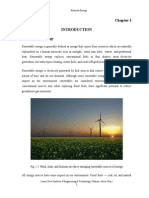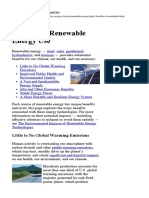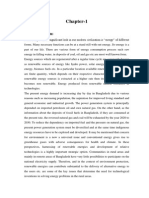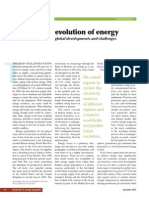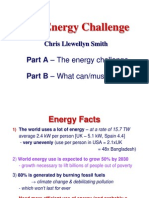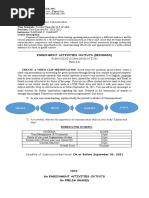Financial Crisis, Energy and Sustainability in Brazil: O L e J G
Financial Crisis, Energy and Sustainability in Brazil: O L e J G
Uploaded by
lucccavlCopyright:
Available Formats
Financial Crisis, Energy and Sustainability in Brazil: O L e J G
Financial Crisis, Energy and Sustainability in Brazil: O L e J G
Uploaded by
lucccavlOriginal Title
Copyright
Available Formats
Share this document
Did you find this document useful?
Is this content inappropriate?
Copyright:
Available Formats
Financial Crisis, Energy and Sustainability in Brazil: O L e J G
Financial Crisis, Energy and Sustainability in Brazil: O L e J G
Uploaded by
lucccavlCopyright:
Available Formats
Financial Crisis, Energy and
Sustainability in Brazil
Oswaldo Lucon e José Goldemberg
A
n immediate consequence of the financial crisis that shook the large
majority of countries is the reduction of economic activity and
increased unemployment. Since economic activity is closely linked
to energy consumption, it is expected that the quantity of energy consumed
will also decrease. At first glance this seems to be good news: with lower
demand, prices should fall, as occurs when stores offer sales.
The strong drop in oil prices, for example, is probably due to this
fact and to the decreased credit that reduces speculation in this sector. In
the past, oil had been sold directly by producers to the companies that
refined it and which then sold it to distributors. In recent years, however,
oil entered the category of commodities – products sold on exchanges. This
sharply increased the number of intermediaries between producers and final
consumers. The commercial and financial operations increased in volume
and sophistication. There was speculation on the price of oil as there was
speculation on real estate debt. The results are now well known. It was usual,
until recently, to have 15- 20 intermediaries in the transaction between oil
producers and distributors. The same took place with natural gas, whose
supply chain is intimately linked to oil. The limited number of oil and gas
suppliers facilitates this process. This does not occur with coal, another
important energy source. Its cost has varied little because there are abundant
resources with broader geographic distribution. There is a larger number of
suppliers and not much opportunity for speculation.
In 2006, fossil fuels (coal, oil, and gas) accounted for 81% of global
energy consumption. Oil alone was responsible for 34%. It can be asked what
will happen when the economies of large countries return to normal and
energy demand rises again, above all in China.
The response is that the current crisis also represents an opportunity
for reorganizing the energy system on more solid and sustainable
foundations. The bases for this reorganization are efficiency, greater
participation of renewable energy sources and the decentralization of energy
production.
First, in the industrialized countries where per capita consumption
is quite high, there is great waste of energy and room for rationalization
estudos avançados 23 (65), 2009 121
of the system. This can lead to significant savings without harming the
quality of the energy. In the developed OECD countries, from 1973 – 2005,
global gains in energy efficiency reached 0.8% per year (IEA, 2007b). In
California, per capita electricity consumption has not increased since the
1970’s, while in the United States as a whole it increased 50% (Figure 1).
This was achieved by laws that established maximum consumption limits
for equipment that use electricity – refrigerators, air conditioners, industrial
and commercial motors and many others. Manufacturers were required to
produce more efficient equipment (Bois, 2006).
Figure 1 – Per capita electricity consumption in the United States and in
California and New York states (Rosenfeld, 2004).
In developing countries, where per capita consumption is relatively
small, energy efficiency alone will not resolve the problem, because in many
cases the final energy services (lighting, heating, cooking etc.) are still
insufficiently available. Thus, global production and consumption of energy
must increase to fulfill this repressed demand.
In this field, the renewable energies (such as wind, solar, biomass and
small scale hydropower) will have a major role to play. Not only are these
energy sources less polluting, but by their nature, are produced in small
units. The decentralization of energy production leads to increased supply
security and the creation of jobs. This occurs particularly in the production
of ethanol from sugar cane in Brazil. The production of ethanol generates
122 estudos avançados 23 (65), 2009
14 – 21 times as many jobs as those needed to the produce the equivalent
amount of energy from oil (Goldemberg, 2004). The opportunities for
bioenergy are extremely promising not only with the currently dominant
biofuels (bioethanol and biodiesel for vehicles, bagasse for electricity, wood
from reforestation for vegetable charcoal for iron foundries and others) but
also with the so-called second generation biofuels (in the case of ethanol
from cellulose, which could be produced anywhere in the world, even
from coniferous trees in cold climates). By 2030, biomass could supply
from 31 – 87 EJ of energy per year. As a comparison, annual global energy
consumption is now 420 EJ (IPCC, 2008).
For the same quantity of electricity, the number of jobs generated
with wind energy is nearly 100 times greater than that generated by nuclear
. The 120 GW of installed capacity in wind turbines throughout the world
produce 260 TWh of electricity and avoid the emission of 158 million tons
per year of CO2, which would occur if this energy was produced from fossil
fuels. This is a market of about US$ 48 billion, which creates some 400,000
jobs. The United States surpassed Germany in wind capacity and 48% of
all its new electrical energy generation comes from this renewable source of
energy (GWEC, 2009)
In addition to wind and biomass, the use of solar energy – with
thermal panels or photovoltaic cells – have local characteristics that frequently
avoid the long distance transportation of energy. The decentralization of
energy generation decreases the vulnerabilities suffered for example by the
oil produced in the Middle East and transported to the United States and
Japan. Energy security is a critical issue for other countries as well. Western
Europe depends on natural gas from Russia that must cross the Ukraine.
Chile depends on gas from Argentina, which needs to import it from
Bolivia, which has difficult relations with Chile. China is vulnerable because
all of the oil it imports must pass through the Straits of Malaga (near
Singapore). Recent developments in solar energy make it possible to generate
electricity on the roofs of buildings and either use it immediately or feed any
surplus into the electrical grid. Completing the energy integration, future
perspectives include electrical vehicles and those moved by hydrogen cells.
The use of geothermal potential is still incipient, but one-kilometer
below the earth’s surface are temperatures of 40 degrees Celsius. The
potential is immense, although there has been little research. It is estimated
that geothermal sources could produce 140 EJ of energy per year worldwide
(IPCC, 2008).
Thus, the current crisis presents opportunities to rebuild the global
energy system on a new more solid and less polluting basis. An efficient
system based on renewable sources would allow reversing the trends in
increased emission of greenhouse gases, for which the use of fossil fuels are
the principal causes.
estudos avançados 23 (65), 2009 123
Although they now have lower participation in the global matrix
(approximately 13% in 2006), renewable energies are not and should not be
considered “alternatives”. In the United States, President Obama has already
defined the following course: invest heavily in new technologies, generate
local jobs, decentralize sources and reduce energy dependency and increase
efficient energy use (especially in vehicles) and the participation of renewable
fuels. His motives are many and include not only the financial crisis, but
also the global environmental crisis (from which the United States had
maintained a distance) and the regional geopolitical and economic influence
of oil producing countries such as Iran and Venezuela.
In Europe, greater energy efficiency and renewable energy sources
have long been identified with long term environmental, social and economic
sustainability. Germany already has wind generating capacity that exceeds
that of the Brazilian Itaipu dam. The UK is the world’s largest financiers of
Clean Development Mechanism projects under the Kyoto Protocol. Denmark
has state of art technology to install large offshore wind turbines and has the
world’s largest energy farm of this kind. Sweden produces biofuels locally and
imports environmentally certified ethanol from Brazil for their vehicles.
Developing countries have adopted various routes. China, aware of its
energy needs, built the world’s largest hydropower dam and has a vigorous
solar energy program. India utilizes large quantities of organic wastes, a
cheap and efficient way to produce energy. For many years, Brazil has been
considered a global leader in renewable energies, thanks to bioethanol and
to its hydropower supply. Other countries such as Nigeria, Venezuela, Boliva
and recently Angola still prefer to rely on their fossil fuel resources. Others
like Haiti, Congo and Zimbabwe still depend on wood from deforestation
and imported oil products.
Russia stands out as a leading source of energy and is now especially
supported by its exports of oil and natural gas. The country has great
potential to become one of the world’s largest producers of bioenergy, when
the fuels produced from cellulose become commercially competitive.
Given this situation, Brazil could take a number of different pathways.
The most evident appears to be inertia, or that is, to use its already explored
hydropower dams, let bioenergy (particularly ethanol) expand, conclude
the Angra 3 nuclear reactor that has been halted for decades and most of all
continue depending on oil. There could also be a vigorous increase in oil
production from the offshore, pre-salt layer, but there are still many doubts
concerning how and when this will be explored. Natural gas can also gain an
increased share, due to exploration of gas fields on the continental shelf. The
reliability of the Bolivian gas supply to the country is still problematic.
Concerning electricity production, the “new” renewable sources
(biomass, wind, small hydro plants) are still considered expensive, given the
price of energy at the purchase auctions promoted by the federal government.
124 estudos avançados 23 (65), 2009
Energy from the Santo Antonio and Jirau hydropower plants on the Madeira
River were bid below R$ 80/MWh, while that from biomass power plants
were contracted for a fixed price of R$ 156/MWh. Electricity from wind
generators costs more than R$ 200/MWh. According to this model, the
bids are won by the proponents who offer energy at the lowest cost when
the plant begins operating, regardless of the quality. This system seems to
be good because it favors consumers but has the perverse result that favors
plants that can be built quickly, even if they are polluting. This is a perfect
recipe for purchasing the worst.
As a rule, the new technologies cost more but only remain more
expensive while they ascend the mandatory steps on their “learning curves”.
Investments in these technologies can be compared with those for oil, gas,
coal and nuclear energy. The national oil company will invest R$ 174 billion,
or nearly US$ 80 billion, from 2009-2013. Of this, US$ 28 billion is for
pre-salt oil deposits, and US$ 2.8 billion for biofuels (Petrobras, 2008).
Subsidies for the production of Brazilian ethanol, estimated at US$30 billion
from 1975 and 2000, reduced the product cost by a factor of three, making
ethanol competitive with gasoline in 2004, without subsidies.
Official projections in the Ten Year Energy Plan – PDE 2008-2017
(MME, 2008) did not consider any increased efficiency that represents
an additional effort in the campaigns underway. Examples of inefficiency
are seen everywhere: electric showers that use 8.000 Watts of power, the
widespread use of incandescent lighting, heavy vehicles that consume
large quantities of fuel (poor quality diesel fuel with high sulfur content
that causes considerable health problems in large cities), priority for road
transport for both cargo and individual passengers.
According to the president of Empresa de Pesquisas Energéticas
[Energy Studies Company, the national energy planning entity], “too much
emphasis is given to sustainability of the physical environment, in detriment
to the other two pillars of sustainable development: social desirability and
economic viability” (Tolmasquim, 2009). The increased participation of
fossil fuelled thermal plants in electricity generation is seen as a punishment
for environmentalists who “opposed” large hydro projects in the Amazon
Region. Environmental licensing is presented as another villian: fossil fuel
plants are easily licensed (including polluting coal plants) but not the hydros.
Meanwhile, it is seen as impractical for Brazil to achieve per capita
consumption of 2.380 kWh by 2020 as called for by a WWF study (2006) on
electrical efficiency. It is true that this would be a low level of consumption
compared to the average in developing countries, but it should be
remembered that most OECD populations are in cold climate regions, which
require more energy. The relatively “low” consumption does not mean that
gains in efficiency are impossible. For example, in 2005 per capita electrical
use in Sâo Paulo was 2.600 kWh (SSE-SP, 2006) and there is clearly
estudos avançados 23 (65), 2009 125
unexplored room for improvements that would not compromise quality of
life. In terms of energy intensity, measured in energy consumption per unit
of GNP, Brazil was the only country to regress (that is, to maintain its rate
above the level of 100%) from 1990-2005 (Figure 2).
The argument that Brazil suffers from poverty and exclusion should
not be used to avoid the adoption of broad – and possible – efficiency
measures. According to the International Energy Agency (IEA, 2007b) each
ton of steel produced in Brazil releases 0.48 Mt of CO2 (compared with only
0.15 MtCO2/ t per ton of steel in Europe, 0.14 in the United States and
0.07 in Japan). The cement sector is relatively efficient, but can reduce its
current 3.6 GJ per ton of clinker to 3 GJ/t. The Brazilian petrochemical and
chemical industries could realistically undergo 20% energy efficiency gains
(IEA, 2007b). Brazilian fossil-fuel power plants have an average efficiency of
36.0%,while the OECD average is 38.6%. Countries such as Austria have an
average of 44% at their plants (IEA, 2007a).
Figure 2 – Total energy consumption per unit of GNP,
per country or region. 1990 = 100%
Despite the scientific consensus about the problem of global warming
and despite the growing convergence of the political positions in the
negotiations around the Climate Convention and the Kyoto Protocol, there
is resistance in the Brazilian federal government to modify old paradigms.
126 estudos avançados 23 (65), 2009
Increased CO2 emissions are still seen as a natural consequence of economic
development. Newspapers show the tip of this iceberg: while news of
catastrophes of a climatic origin is concentrated in the “Science” sections, the
Economic sections highlight increased oil production. Local disasters, such
as floods and drops in agricultural production are treated as consequences
without causes, or as “scientists warnings”. This should not be the position
of a country as dependent on climate as ours.
There are few legislative initiatives to truly prepare society to confront
global warming by adapting to its impacts and mitigating the causes. Most
measures focus on stimulating the so-called “carbon credits”, through the
Clean Development Mechanism (CDM). These initiatives are important, but
far from sufficient: while CDM projects worldwide should mitigate nearly 0.8
billion tons of carbon equivalents (GtCeq) by 2012 (CDM Executive Board,
2009), total emissions must be reduced by 214 times this amount by 2050,
or nearly 175 Gt Ceq (Pacala & Socolow, 2004).
Despite the general awareness that there are problems caused by
emissions of greenhouse gases, especially CO2, changes in unsustainable
production and consumption habits are not planned. The proposed São
Paulo State Climate Change Policy law (Alesp, 2009), sent by the governor
to the state Assembly, was strongly criticized in much of the media for
“opening the road to urban tolls and to intermunicipal rotation of vehicle
use”. Although it does not call for either of these measures, no other point of
the proposal was debated. One very important aspect of the project that was
ignored by the media is the goals for reduced emissions, references for future
laws, policies, plans and projects in the fields of energy, transportation, urban
planning, land use controls and many others. The idea that the goals affect
economic competitiveness is false. Japan is an example of a country that
incorporated significant technological innovations needed for a low carbon
intensity energy profile. By means of intelligent buildings, Japan, Germany,
Britain and many other countries have significantly reduced their energy
consumption and greenhouse gas emissions.
The financial crisis, at its core, is one more reflection of the crisis
of sustainability presented by history. There were other crises in the past,
also linked to excessive exploitation of resources, speculation, inflation and
scarcity. The immediate consequences were loss of lives, war, economic
deceleration and unemployment. Some societies have disappeared, such as
that of Easter Island. Others never recover, like the Roman Empire. Many
survive and some grow and evolve, investing in innovation and efficiency.
The post war periods show us which were the good examples. Brazil is a
country with abundant natural resources, but it must choose its route before
it looses its comparative advantages.
estudos avançados 23 (65), 2009 127
Bibliography
ALESP. Política Estadual de Mudanças Climáticas – PEMC, Projeto de Lei
(1/2009). Assembléia Legislativa do Estado de São Paulo, 2009. Available at:
<http://www.al.sp.gov.br> & <http://www.al.sp.gov.br/portal/site/Internet/Li
staProjetos?vgnextoid=b45fa965ad37d110VgnVCM100000600014acRCRD&ti
po=1>. CDM Executive Board, 2009, Statistics, February 11. Available at : http://
cdm.unfccc.int/Statistics/index.html>.
BOIS, D. California Energy Commissioner Recommends Investing in
Efficiency. Energy Priorities, 2006. Available at: <http://energypriorities.com/
entries/2006/02/ california_energy_commissioner.php>.
GOLDEMBERG J. The Case for renewable Energy. Renewables 2004 Conference.
Bonn. Available at: <http://www.renewables-bonn-2004.de/pdf/tbp/TBP01-
rationale.pdf>.
GWEC. US and China in race to the top of global wind industry, Global Wind
Energy Council News, 2 February, 2009. Available at: <http://www.gwec.net/
index.php?id=30&no_cache=1&tx_ttnews%5Btt_news%5D=177&tx_ttnews%5Bba
ckPid%5D= 4&cHash=04fdc8c00a>.
IEA. Energy Efficiency Indicators for Public Electricity Production from Fossil
Fuels. Information Paper in support to the G8 Plan of Action, 2007a.
_______. Worldwide Trends in Energy Use and Efficiency. Key Insights from IEA
Indicator Analysis In support of the G8 Plan of Action. Paris: International Energy
Agency, 2007b.
IPCC. Scope Meeting on Renewable Energy Sources – Proceedings. Lubeck,
Alemanha, 20 a 25 jan. 2008.
MME. Plano Decenal de Energia – PDE 2008-2017. 2008. Available at: <www.
mme.gov.br>.
OESP. Crise de crédito pode reduzir investimento em etanol, diz Unica. O Estado
de S. Paulo, 14 out. 2008. Available at: <http://www.estadao.com.br/economia/
not_eco259786,0.htm>.
PACALA, S.; SOCOLOW, R. Stabilization Wedges: Solving the Climate Problem
for the Next 50 Years with Current Technologies. Science, v.305, p.968-71, 2004.
PETROBR AS. Plano de negócios 2009-2013. Apresentação de José Sergio Gabrielli
de Azevedo, Presidente, 2008. Available at: <http://www2.petrobras.com.br/ri/
port/ConhecaPetrobras/EstrategiaCorporativa/pdf/PN_2009-2013_Port.pdf>.
Rosenfeld, A. Emerging technologies – past, present and future. Emerging
Technologies in Energy Efficiency – Summit 2004, 2008. San Francisco,
14.10.2004.
California Enegy Commission. Available at: <http://www.energy.ca.gov/
commissioners/rosenfeld_docs/index.html>.
SSE-SP. Balanço energético do Estado de São Paulo 2006, ano base 2005.
Secretaria de Saneamento e Energia. Available at: <http://www.energia.sp.gov.br>.
128 estudos avançados 23 (65), 2009
TOLMASQUIM, M. O paradoxo ambiental. Carta Capital, São Paulo,
30 jan. 2009. Available at: <http://www.cartacapital.com.br/app/materia.
jsp?a=2&a2= 6&i=3271>.
W WF. Agenda Elétrica Sustentável 2020. Worldwide Fund for Nature, 2006.
Available at: <www.wwf.org.br>.
A bstract – The recent global financial crisis reduces economic activity and
consequently energy consumption. This may be an important opportunity to
reorganize the energy system on more solid and sustainable foundations: efficiency,
higher share of renewables and decentralized energy production. Brazil and other
developing countries can leapfrog the experience of developed nations in energy
efficiency, complementing this with a vigorous program in renewables, particularly
“modern” sources (wind, solar, biomass and small hydro plants). However, there is a
concern about inertia in the Brazilian scenario, based on an increasing share of fossil
fuels in the matrix, in prioritizing resources for oil and gas exploration and in the
continuing unsustainable production and consumption standards.
K eywords : Financial crisis, Energy efficiency, Renewables, Sustainability, Policies,
Fossil fuels.
estudos avançados 23 (65), 2009 129
Oswaldo Lucon is technical assistant to the Secretary of the Environment of São
Paulo. @ – oswaldolucon@yahoo.com.
José Goldemberg is professor at the Instituto de Eletrotécnica e Energia da USP.
He was Secretary of the Environment in São Paulo (2002-2006) and dean of
the Universidade de São Paulo (1986-1990). In the federal government he was
secretary of Science and Technology (1990-1991) and minister of education (1991-
1992). @ – goldemb@iee.usp.br.
Received on 2.13.2009 and accepted on 2.17.2009.
Translated by Jeffrey Hoff. The original in Portuguese is available
at http://www.scielo.br/scielo.php?script=sci_issuetoc&pid=0103-
401420090001&lng=pt&nrm=iso.
130 estudos avançados 23 (65), 2009
You might also like
- Fidic Conditions of Contract Free Download PDFDocument2 pagesFidic Conditions of Contract Free Download PDFRachelle55% (11)
- Interview - Questions - Workday HCM FAQ'S by L9GSDocument14 pagesInterview - Questions - Workday HCM FAQ'S by L9GSHaritha90% (10)
- Community Project Report On YogaDocument46 pagesCommunity Project Report On YogaManik Preet Singh67% (3)
- Iii - Energy and Climate Global Energy Demand and Supply-Present and FutureDocument5 pagesIii - Energy and Climate Global Energy Demand and Supply-Present and Futureandrei CalloNo ratings yet
- Energy Systems 2Document13 pagesEnergy Systems 2Sudesh Fernando Vayanga SubasinghaNo ratings yet
- EnergyManagement2 PDFDocument10 pagesEnergyManagement2 PDFandrei CalloNo ratings yet
- Environmental Ecology - 8Document23 pagesEnvironmental Ecology - 8Seble GetachewNo ratings yet
- What Is Energy CrisisDocument7 pagesWhat Is Energy CrisisShreyas MhaskeNo ratings yet
- Power To PeopleDocument20 pagesPower To PeopleAndrew NguyenNo ratings yet
- Project On: Sustainable Energy: College of Engineering and Technology Department of Chemical EngineeringDocument9 pagesProject On: Sustainable Energy: College of Engineering and Technology Department of Chemical EngineeringfanusNo ratings yet
- Global Wind Energy OUTLOOK 2006: September 2006Document60 pagesGlobal Wind Energy OUTLOOK 2006: September 2006Paulo MenegazNo ratings yet
- Alternative Energy SourcesDocument6 pagesAlternative Energy Sourcesspring lookNo ratings yet
- Energy Innovation Nov 30 2015Document9 pagesEnergy Innovation Nov 30 2015Poncho76No ratings yet
- Chapter-1: 1.1 Renewable EnergyDocument62 pagesChapter-1: 1.1 Renewable EnergyMohanSharmaNo ratings yet
- Benefits of Renewable Energy UseDocument11 pagesBenefits of Renewable Energy UseMikashitamoari J. KarlozNo ratings yet
- Sun, Wind and Desert: MENA, the upcoming Clean Energy World ChampionFrom EverandSun, Wind and Desert: MENA, the upcoming Clean Energy World ChampionNo ratings yet
- Searching For Alternative Energy SolutionsDocument24 pagesSearching For Alternative Energy SolutionsVijay PatelNo ratings yet
- Semi 5Document24 pagesSemi 5Anivesh JaiswalNo ratings yet
- Renewable Energy Alternatives: October 3-6, 2008Document23 pagesRenewable Energy Alternatives: October 3-6, 2008mshahidshaukatNo ratings yet
- Final Year ProjectDocument56 pagesFinal Year ProjectBiniam SolomonNo ratings yet
- 02 Global Energy ScenarioDocument55 pages02 Global Energy Scenarioiqbal_arch79100% (1)
- Rajagopal-Annual Reviews 2009 FinalDocument24 pagesRajagopal-Annual Reviews 2009 FinalPaula MartinsNo ratings yet
- Renewable Energy: Name: Ahmed Mohamed Farouk Abdo Reg: 08100954Document11 pagesRenewable Energy: Name: Ahmed Mohamed Farouk Abdo Reg: 08100954Ahab CaptainNo ratings yet
- Chapter 08Document30 pagesChapter 08rjnprNo ratings yet
- WRIT122 - Final Essay - RalyaDocument8 pagesWRIT122 - Final Essay - Ralyaralyaj510No ratings yet
- Global Energy Crisis: Impact On The Global Economy: December 2021Document11 pagesGlobal Energy Crisis: Impact On The Global Economy: December 2021Minh Ánh HoàngNo ratings yet
- PEST Analysis of Wind Energy in The World From TheDocument8 pagesPEST Analysis of Wind Energy in The World From TheWishva WidanagamageNo ratings yet
- Harnessing Untapped Biomass Potential Worldwide 129Document26 pagesHarnessing Untapped Biomass Potential Worldwide 129danielraqueNo ratings yet
- Harnessing Untapped Hydropower 79Document52 pagesHarnessing Untapped Hydropower 79danielraqueNo ratings yet
- The Future of Hydrogen - Opportunities and Challenges: Michael Ball, Martin WietschelDocument13 pagesThe Future of Hydrogen - Opportunities and Challenges: Michael Ball, Martin WietschelIshan PatilNo ratings yet
- Seminar Report 007Document9 pagesSeminar Report 007Chandresh KulshresthaNo ratings yet
- Algae BiofuelsDocument22 pagesAlgae BiofuelsfedericodeviennaNo ratings yet
- Chapter 1Document64 pagesChapter 1kavithaNo ratings yet
- CC C CCCCCCCCCC CC CC C!"#$%C &#&%!C''&#C CC' C C C+, C - .C /c0c+Document7 pagesCC C CCCCCCCCCC CC CC C!"#$%C &#&%!C''&#C CC' C C C+, C - .C /c0c+yo2boyNo ratings yet
- Global energy crises transition to non renewable eDocument9 pagesGlobal energy crises transition to non renewable ep18631801No ratings yet
- Chpt. 7: Non-Renewable Energy SourcesDocument17 pagesChpt. 7: Non-Renewable Energy SourcesNicholas WhiteNo ratings yet
- Round 2 SpeechDocument6 pagesRound 2 SpeechIanNo ratings yet
- Win-Win Opportunity For Climate Prosperity and Life Op-Ed 07-01-08Document4 pagesWin-Win Opportunity For Climate Prosperity and Life Op-Ed 07-01-08Michael P TottenNo ratings yet
- 3uràwdeoe 6roxwlrqs Wo &olpdwh, 2lo, DQD 3urolihudwlrqDocument13 pages3uràwdeoe 6roxwlrqs Wo &olpdwh, 2lo, DQD 3urolihudwlrqEdward DouglasNo ratings yet
- Semi 2Document28 pagesSemi 2Himanshu AwasthiNo ratings yet
- Wind Energy and Sustainable Electricity Generation: Evidence From GermanyDocument14 pagesWind Energy and Sustainable Electricity Generation: Evidence From Germanydimasbrahmana22No ratings yet
- Renewable Energy Is Energy That Is Collected FromDocument8 pagesRenewable Energy Is Energy That Is Collected FromDarya KhanNo ratings yet
- Summary: Power Hungry: Review and Analysis of Robert Bryce's BookFrom EverandSummary: Power Hungry: Review and Analysis of Robert Bryce's BookNo ratings yet
- 文档Document3 pages文档johnkenmaybrockNo ratings yet
- Research Enc 1102Document12 pagesResearch Enc 1102api-253174307No ratings yet
- 06185747Document5 pages06185747nguyenductuyenNo ratings yet
- Biomass For Energy in Germany Status, Perspectives and Lessons LearnedDocument10 pagesBiomass For Energy in Germany Status, Perspectives and Lessons Learnedpluck_boyNo ratings yet
- Section 1. IntroductionDocument3 pagesSection 1. IntroductionArchi Wsm100% (1)
- Bs Bab 6Document12 pagesBs Bab 6A-Meen HadiNo ratings yet
- 4 Sadorsky-2009-RenewableenergyconsumptionCO2emissionsandoiDocument8 pages4 Sadorsky-2009-RenewableenergyconsumptionCO2emissionsandoijulio CmNo ratings yet
- Researchpaper 2Document6 pagesResearchpaper 2api-341968143No ratings yet
- Alevel 2007 Q10Document2 pagesAlevel 2007 Q10Nguyễn Tuấn AnhNo ratings yet
- Energy Argumentation Dave Wimert Student HandoutDocument8 pagesEnergy Argumentation Dave Wimert Student HandoutScottNo ratings yet
- Impact of Key Renewable Energy Sources-Alfa Betha Muhammad-Gbw UnnesDocument13 pagesImpact of Key Renewable Energy Sources-Alfa Betha Muhammad-Gbw Unnesmbem090919No ratings yet
- 1.2 Energy and Sustainable Development: 2 Principles of Renewable EnergyDocument3 pages1.2 Energy and Sustainable Development: 2 Principles of Renewable EnergyRaisa D. Carmen Trujillo RivasNo ratings yet
- Case StudyDocument48 pagesCase Studyazhanali076No ratings yet
- Carbon Emission and Mitigation Cost Comparisons Between Fossil Fuel, Nuclear and Renewable Energy Resources For Electricity GenerationDocument12 pagesCarbon Emission and Mitigation Cost Comparisons Between Fossil Fuel, Nuclear and Renewable Energy Resources For Electricity GenerationShanzib Sadhukhan ShubhoNo ratings yet
- The Importance of Renewable Energy in Combating Climate ChangeDocument3 pagesThe Importance of Renewable Energy in Combating Climate ChangevvkchowdaryNo ratings yet
- Electricity and Heating Run The WorldDocument2 pagesElectricity and Heating Run The WorldMelanie Navarro SaguianNo ratings yet
- Biomass As An Alternative Source of EnergyDocument8 pagesBiomass As An Alternative Source of EnergyDenielle MarceñoNo ratings yet
- The Energy Challenge: Part A Part BDocument57 pagesThe Energy Challenge: Part A Part BAmit BakleNo ratings yet
- On Energy ConservationDocument21 pagesOn Energy ConservationGajendra TeliNo ratings yet
- IFS UmerDocument11 pagesIFS UmerAhadism AnalysisNo ratings yet
- AsimoDocument8 pagesAsimoManoj KumarNo ratings yet
- Prosafe Gs516Tp Gigabit Poe/Pd Smart Switch: Hardware Installation GuideDocument31 pagesProsafe Gs516Tp Gigabit Poe/Pd Smart Switch: Hardware Installation GuideandywanderNo ratings yet
- MB0039 SLM Unit 05Document20 pagesMB0039 SLM Unit 05Kamal RaiNo ratings yet
- Pale Case Digests CompleteDocument185 pagesPale Case Digests CompleteShiela Marie100% (5)
- 15 Year SSC CGL GK PDF in Hindi-2Document21 pages15 Year SSC CGL GK PDF in Hindi-2ajay100% (1)
- Quiz 2: Spring 1996Document40 pagesQuiz 2: Spring 1996Vivek AnandanNo ratings yet
- Finite Element Analysis of Aircraft Wing Using Composite StructureDocument22 pagesFinite Element Analysis of Aircraft Wing Using Composite StructureAumair MalikNo ratings yet
- Special Casting ProcessesDocument31 pagesSpecial Casting Processesdarshan_rudraNo ratings yet
- Taudem 5.1 Quick Start Guide To Using The Taudem Arcgis ToolboxDocument37 pagesTaudem 5.1 Quick Start Guide To Using The Taudem Arcgis ToolboxCassie SmithNo ratings yet
- Automatic Musical Water FoundationDocument4 pagesAutomatic Musical Water Foundationieee4mybusinessonlyNo ratings yet
- Method Statement For Application of Drywall PaintDocument6 pagesMethod Statement For Application of Drywall PaintReuben James BangaoilNo ratings yet
- Country Paper:: Dominican RepublicDocument101 pagesCountry Paper:: Dominican RepublicPablo Guillermo Coca GarabitoNo ratings yet
- RFQ Line Pipe GTCLDocument43 pagesRFQ Line Pipe GTCLAJAY PatilNo ratings yet
- Anchor Handling Method Statement 0Document3 pagesAnchor Handling Method Statement 0YevgeniyNo ratings yet
- Judgement UC 17 Dec 2024Document36 pagesJudgement UC 17 Dec 2024RaghuNo ratings yet
- SAPGUIforJava TechEd2007Document10 pagesSAPGUIforJava TechEd2007Gerardo ArellanoNo ratings yet
- Computer Architecture and Organization: Lecturer: Pazir AhmadDocument10 pagesComputer Architecture and Organization: Lecturer: Pazir AhmadfayeqNo ratings yet
- Competency Assessment TemplateDocument2 pagesCompetency Assessment Templateduit seposen0% (1)
- Inset 2022-2023Document4 pagesInset 2022-2023Jess Ian LlagasNo ratings yet
- Design and Simulation of VoIP System For Campus Usage A Case Study at PTUDocument5 pagesDesign and Simulation of VoIP System For Campus Usage A Case Study at PTUEditor IJTSRDNo ratings yet
- ENRICHMENT ACTIVITIES OUTPUTS (Purposive Communication)Document2 pagesENRICHMENT ACTIVITIES OUTPUTS (Purposive Communication)DM Camilot IINo ratings yet
- Open Vizsla CatalogueDocument7 pagesOpen Vizsla Cataloguelantoskatalin59No ratings yet
- Current Affair World TimesDocument30 pagesCurrent Affair World TimesMujahid iqbalNo ratings yet
- January 9, 2020Document18 pagesJanuary 9, 2020dont askNo ratings yet
- Wiring Diagram - "Fail Secure" Electric Strike, Poe Power SupplyDocument11 pagesWiring Diagram - "Fail Secure" Electric Strike, Poe Power SupplyJimit ShahNo ratings yet
- Cambridge International Advanced Subsidiary and Advanced LevelDocument16 pagesCambridge International Advanced Subsidiary and Advanced LevelAl-Sami MashrafeeNo ratings yet













